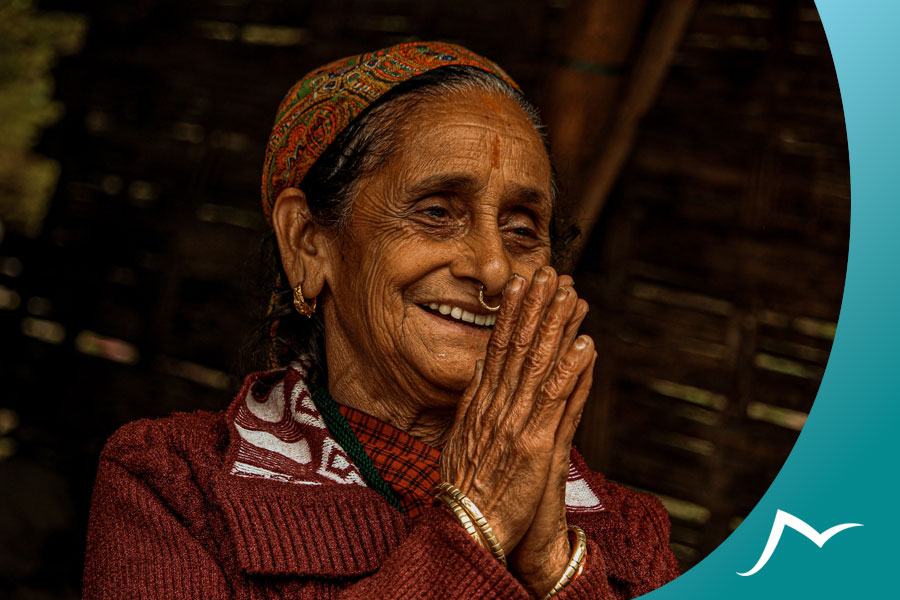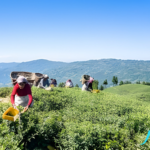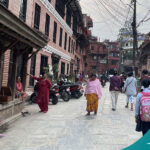With over a hundred ethnicities and languages, Nepal is a country of cultural abundance, home to many customs and traditions. An essential component of this rich diversity is the wide variety of greetings people in different regions use. Understanding these greetings is crucial to gaining insight into the fundamental beliefs that guide Nepali society.
Greetings in Nepali Society are more than just a means of communication; they symbolize respect, hospitality, and fellowship. Furthermore, in the Nepali culture, greetings play a significant role in developing and preserving relationships. From an ordinary “Namaste” to grand religious rituals, greetings here reflect the country’s abundance of cultures.
Understanding the meaning and the context of greetings in Nepal is helpful for visitors to help them avoid any potential misunderstandings in their social interactions. Additionally, it offers insight into the history of Nepal and how its societal structure has changed over the years.
This article will look into “Greetings in Nepali Society” more thoroughly, covering the different types of greetings used in Nepal, their significance, and how they may display power dynamics and the ever-evolving social norms.
Importance of greetings in Nepali society
Greetings in Nepali Society are essential and are a significant part of the culture. How individuals greet one another reveals the values and customs fundamental to Nepali society. This section will investigate the importance of greetings in Nepali culture, including the function of respect and hospitality, the customary greetings, and their interpretations and contexts.

Respect and Courtesy
Nepali culture stresses the necessity of exhibiting respect toward other people. The method of greeting one another illustrates both individuals’ respect for each other. This is particularly true for older people who greatly admire Nepali culture. The customary way of greeting seniors is with clasped hands and a slight bow of the head to express respect and humbleness.
Moreover, hospitality is an essential aspect of Nepali culture. Nepalis are known for their friendliness and warmth when welcoming guests; greetings play a significant role. Usually, guests are received with a cheerful smile and either a cup of tea or a snack as a sign of hospitality.
Common Greetings in Nepali Society
The most common greeting used in Nepal is “Namaste.” This greeting is used to say hello and goodbye and is paired with folded hands in front of the chest and a bow of the head. The term “Namaste” originates from Sanskrit and is made up of two words – “namah,” which means “I bow to you,” and “te,” which means “you.”
Another widespread greeting in Nepal is “Tashi Delek,” a Tibetan salutation. This greeting is typically used in the northern regions of Nepal, where the Tibetan population is high. The greeting translates to “blessings and good luck to you.”
Meanings and Contexts of Greetings in Nepali Society
Greetings in Nepali Society have deeper implications than merely being a form of social communication; they reflect the scenario in which they are employed. For instance, the greeting used when addressing an elder or someone in authority differs from when speaking to a friend or an equal. Greetings are also employed in contexts such as religious rites or social gatherings.
During religious ceremonies, greetings tend to be more elaborate and formal. During the celebration of Dashain, it is customary to offer a “tika,” a red vermillion paste, to the person being greeted and to express the greeting of “Dashain Tika.”
How greetings may vary across different regions of Nepal
Although “Namaste” is the most commonly used greeting in Nepal, there are regional variations in how people greet each other. These variations reflect the diversity of Nepali culture and the influence of geography, language, and history. In this section, we will explore the regional variations in greetings in Nepal, providing examples and explaining their significance.
Regional Variations in Greetings in Nepali Society
Nepal is a diverse country with many different ethnic groups and languages. This diversity is reflected in the way people greet each other. For example, in the Terai region, Nepal’s southern plain region, people greet each other with “Salam.” This greeting is borrowed from Urdu and is commonly used by the Muslim population in the region. In hilly areas, people may use different greetings depending on the ethnic group they belong to. For example, the Newar community in the Kathmandu valley greets each other with “Jwai Mhacha,” which means “Let’s live long.” This Comunity also use the term ‘Taremam’ to say hellow each other.
The geography, language, and history of Nepal have all played a role in influencing the different regional variations of greetings. For example, in the western region of Nepal, mainly populated by the Tharu community, people greet each other with the word “Khaduwa,” derived from the Tharu language, which means “How are you?”. Similarly, in the eastern region, mainly inhabited by the Limbu community, people use the word “Yakthungba” to greet each other, which translates to “Hello” in the Limbu language.

Social Etiquette for Greetings in Nepali Society
In Nepal, greetings are integral to social interaction, and following the correct social etiquette is imperative when exchanging pleasantries. Specifically, the social etiquette for greetings depends on the relationship between the individuals, their age, and the interaction context. Regarding formal settings such as business meetings or religious ceremonies, using more formal greetings such as “Namaste” or “Namaskar” is preferable. On the other hand, in informal settings like amongst friends and family, casual greetings like “Sanchai?” (which means “What’s up?”) are preferred.
Common Social Situations Where Greetings are Important
Greetings are a must-have component in many social scenarios in Nepal. For example, during religious ceremonies, it is important to greet the deities, the lama or priest in charge, etc. During business meetings, it is customary to greet the person you are meeting with a formal greeting like “Namaste.” And lastly, when meeting someone for the first time, offering a greeting is a sign of respect.
Body Language and Nonverbal Cues
Besides verbal greetings, body language and nonverbal cues also help convey the meaning of greetings. To illustrate, a slight bow of the head, folding of hands, or placing hands on the chest indicates respect and that the greeting is genuine. Moreover, making eye contact during the greeting can convey sincerity, and the other person will know you are actively involved in the interaction.
The Role of Greetings in Nepali Society
In Nepali culture, greetings are more than mere formalities; they are a way to connect with others and build relationships. Greetings can be used to express gratitude, show respect, and convey a sense of warmth and hospitality. They are also used to acknowledge the other person’s presence and form a bond between two individuals. Thus, greetings are essential in establishing a sense of community in Nepali society.
Reinforcing Social Hierarchies and Power Dynamics
Though they are intended to make social interactions smoother, greetings can also have an indirect influence in reinforcing social hierarchies and power dynamics in Nepali society. For example, when greeting elders or people in positions of authority, it is mandatory to use more formal greetings, which implies respect and acceptance of those in positions of power—similarly, using informal greetings with someone older or in a higher place than you is frowned upon and seen as disrespectful.
Changing Nepali Society
As Nepali society evolves, how people greet each other will likely change. For instance, as the country progresses, traditional greetings might be replaced by more casual or westernized ones. Additionally, greetings may differ based on cultural backgrounds in a more diverse society. Despite these alterations, the importance of greetings in Nepali society will remain, as they are essential for building connections and relationships.
FAQs
What are some common non-verbal gestures used for greetings in Nepali Society?
Non-verbal gestures such as placing one’s hands together in a prayer-like position (Namaste) or touching the feet by forehead of an elder (Dhog) are common ways to greet someone in Nepal.
Are there any taboos or cultural norms to be aware of when greeting someone of a different gender or age?
It is customary to greet someone of a different gender or age with a respectful tone and manner and to use appropriate titles such as “didi” (older sister) or “dai” (older brother).
How do greetings differ between urban and rural areas in Nepal?
In rural areas, traditional forms of greeting, such as touching the feet by forehead of elders and using more formal language, are more common, while in urban areas, folding hands in front of the chest and a bow of the head(Namaste), touching the feet of an elder (Charan Sparsh), handshakes and conversational language may be more prevalent.
What is the appropriate way to greet someone who is grieving or going through a difficult time in Nepal?
It is customary to offer condolences and show support through gestures such as bringing food or assisting with household tasks.
Are there any variations in greetings between different ethnic groups in Nepal?
Yes, different ethnic groups in Nepal have their unique forms of greeting. For example, the Newar community often greets with “Namaskar” and “Jwai Bhaye,” while the Tharu community may use “Ram Ram” or “Jaimala.”
How have globalization and modernization affected traditional greeting customs in Nepal?
Globalization and modernization have led to the adoption of more casual forms of greeting, such as handshakes and hugs, particularly among younger generations in urban areas. However, traditional forms of greeting are mostly practiced in all over the Nepal.
Wrap Up
In sum, this article delved into the significance of greetings in Nepali society. It explored the various local variations of salutations, social protocols for greetings, and the role of greetings in the country. This discussion demonstrated how these greetings provide insights into a culture’s morals and ideals and are essential for building and maintaining a strong sense of community in Nepal.
Acknowledging and respecting Nepal’s diverse salutations and understanding how they reflect the country’s broader cultural convictions and values is crucial. By doing so, we can deepen our appreciation and admiration for Nepali culture and society and improve our interactions with Nepali individuals and communities, whether traveling to Nepal, collaborating with Nepali peers, or simply communicating with Nepali people in our daily lives.




Namaste is addictive! On my last trip to Nepal, I might have managed to Namaste everyone I met! Such a wonderful greeting, Keep up the excellent work!